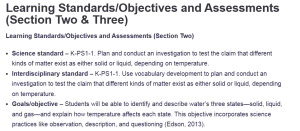Learning Standards/Objectives and Assessments (Section Two & Three)
Learning Standards/Objectives and Assessments (Section Two)
- Science standard – K-PS1-1. Plan and conduct an investigation to test the claim that different kinds of matter exist as either solid or liquid, depending on temperature.
- Interdisciplinary standard – K-PS1-1. Use vocabulary development to plan and conduct an investigation to test the claim that different kinds of matter exist as either solid or liquid, depending on temperature.
- Goals/objective – Students will be able to identify and describe water’s three states—solid, liquid, and gas—and explain how temperature affects each state. This objective incorporates science practices like observation, description, and questioning (Edson, 2013).
Modifications and Support (Section Three)
Student Engagement
Modification for Diverse Needs – Instruction for diverse learning styles will be adjusted by providing visual aids such as images of ice, water, and steam, as well as hands-on experiences such as handling ice and observing steam. Visuals and gestures will be used to reinforce vocabulary for ELL students.
Technology Integration
Technology Tools – Tablets will be used to view time-lapse videos showing water changing states or interactive water cycle animations. A digital thermometer will also be used for hands-on tracking of temperature changes.
Learning Environment
Physical Setup – Learning stations will be arranged around the classroom where students can interact with ice, water, and steam (using safe heat sources like warm water rather than boiling water for safety). Learning materials will be placed on low tables for accessibility.
Materials
- Ice
- Water
- Steam
- Ice cubes
- Cups of water
- Thermometers
- Digital devices for observing changes.
- These tools support the lesson’s hands-on, inquiry-based goals
Language/Literacy
- Key Vocabulary
- States
- Temperature
- Melt
- Freeze
- Evaporate
- Condensation
- Instructional Strategies—Use picture cards and simple experiments to reinforce terms and ask for prompt discussions about students’ observations, like describing what they see as ice melts or water evaporates.
- Cross-disciplinary Connections
- Math: Counting ice cubes or measuring water.
- Literacy: Describing observations in journals.
- Social/Emotional: Encouraging teamwork during experiments.
- Social Studies: Discuss how water is used globally and connect to community experiences.
- Essential Questions (Using Bloom’s Taxonomy)
- What happens to ice when it gets warmer? (Knowledge)
- Why do you think water turns into steam? (Understanding)
- Can you predict what will happen if we freeze water again? (Application)
Reference
Edson, M. T. (2013). Starting with science: Strategies for introducing young children to inquiry. Stenhouse Publishers.
ORDER A PLAGIARISM-FREE PAPER HERE
We’ll write everything from scratch
Question
OKAY, SO THIS IS SECTION PART 2 & 3 OF MY LESSON PLAN. I UPLOADED PART 1 AS WELL SO YOU CAN CONTINUE FROM THERE. THE TEXTBOOK IS UPLOADED TO THE ORDER FOR PART 1 SO PLEASE REVIEW ORDER #58390 for the uploads of the entire textbook. Also, I UPLOADED THE INSTRUCTIONS MY PROFESSOR PROVIDED FOR SECTIONS 2 & 3 BE SURE TO REVIEW. ALSO, PLEASE BE MINDFUL THAT THIS LESSON PLAN IS IN 6 PARTS, AND WHEN I AM ABLE TO UPLOAD PART 6, I WILL NEED PROOF OF KINDERGARTEN STUDENTS ENGAGING IN THE LESSON THAT CAN’T BE FOUND ON THE INTERNET. BUT FOR RIGHT NOW PLEASE REVIEW ALL INSTRUCTIONS FOR PARTS 2 & 3. ALSO, REVIEW PART 1 AS WELL AND THE BOOK IS ATTACHED TO ORDER #58390.
LINK TO BLOOMS TAXONOMY BIG QUESTIONS YOUNG MINDS E-BOOK: https://lehman.ezproxy.cuny.edu/login?url=https://search.ebscohost.com/login.aspx?direct=true&db=e000xna&AN=2344709&site=ehost-live
Learning Standards/Objectives & Assessments (Section Two)
Learning Standards Associated with this lesson (at least one science standard and one interdisciplinary standard)
Goals/objective for this specific lesson:
- Identify 1 (one) of the standards above and create an objective/learning goal based on your chosen standard (i.e. “Students will be able to….”) Be sure your objective takes into account the 8 practices of science – of course not all of them, but it should include some.
Learning Standards/Objectives and Assessments (Section Two & Three)
Modifications & Support (section three)
Student Engagement:
a.) How will you modify this lesson to address students’ specific learning needs, ensure their active engagement, and learning goal in this specific lesson?
Technology Integration:
a.) How and what forms of technology will be integrated into this specific lesson?
Learning Environment:
a.) How will the physical environment reflect and support the learning goal of this specific lesson?
Materials:
a.) List the materials you will use to support the learning goal of this specific lesson?
Language/Literacy:
- What key vocabulary will students be introduced to that will support the learning goal in this specific lesson?
- Briefly describe/list instructional strategies that you will use to support students’ science development specific to this lesson?
- Briefly describe connections to math, literacy, social studies and/or social and emotional learning in this lesson.
- Use Bloom’s Taxonomy (Big Questions for Young Minds) to develop essential questions to encourage critical thinking based on this specific lesson.


